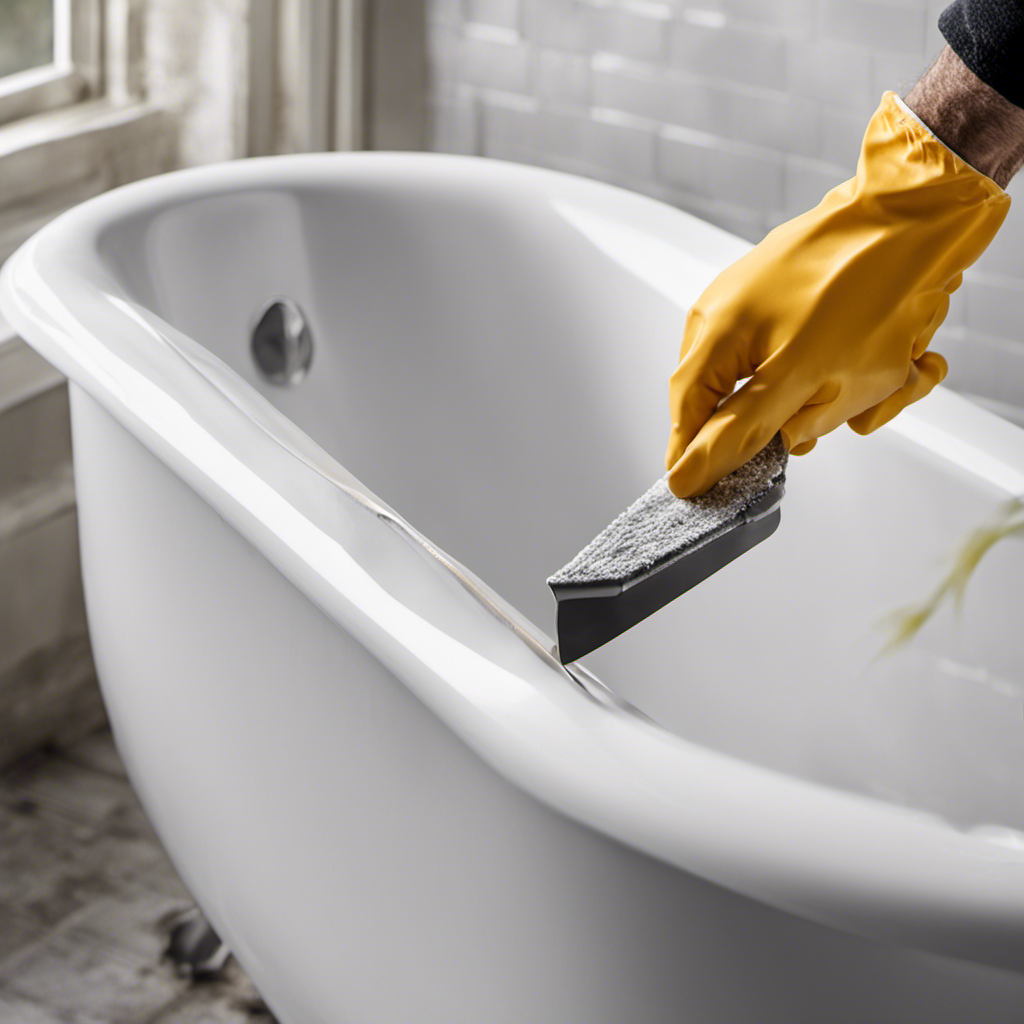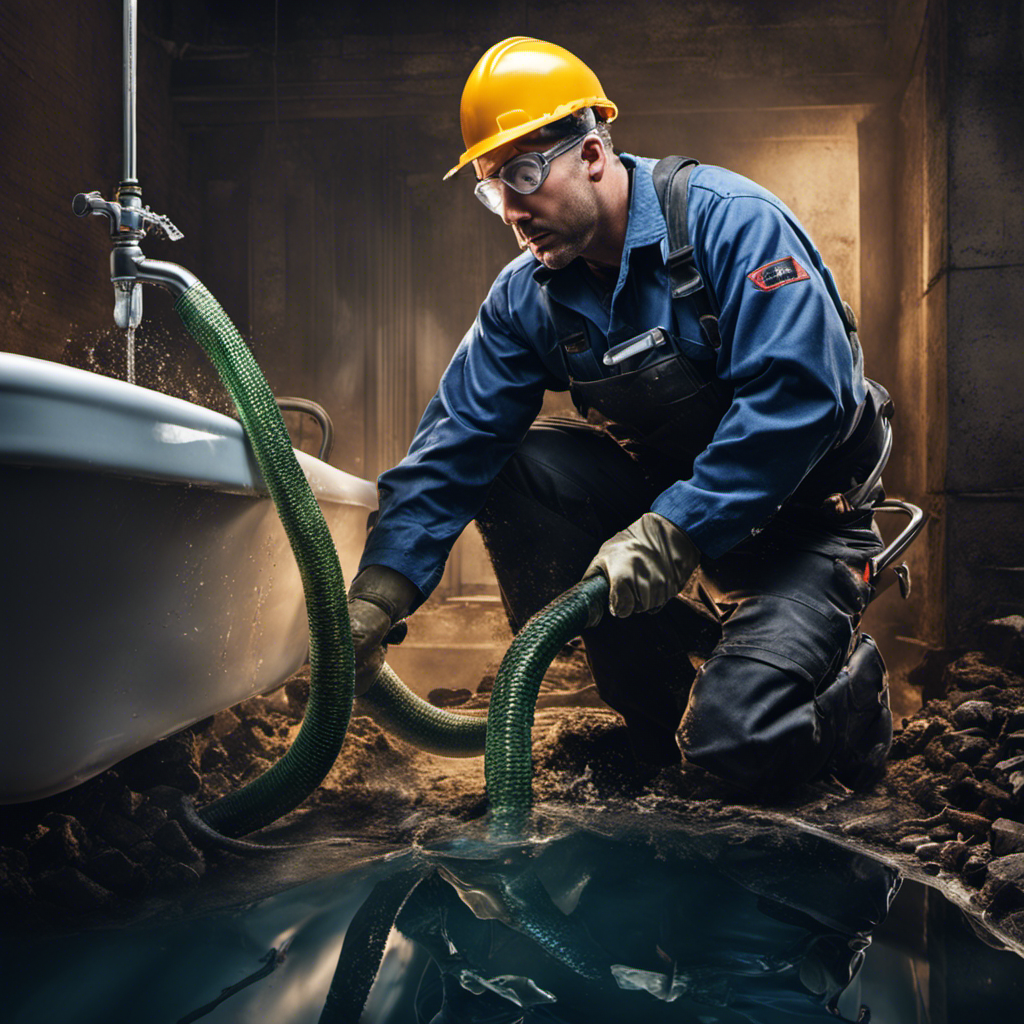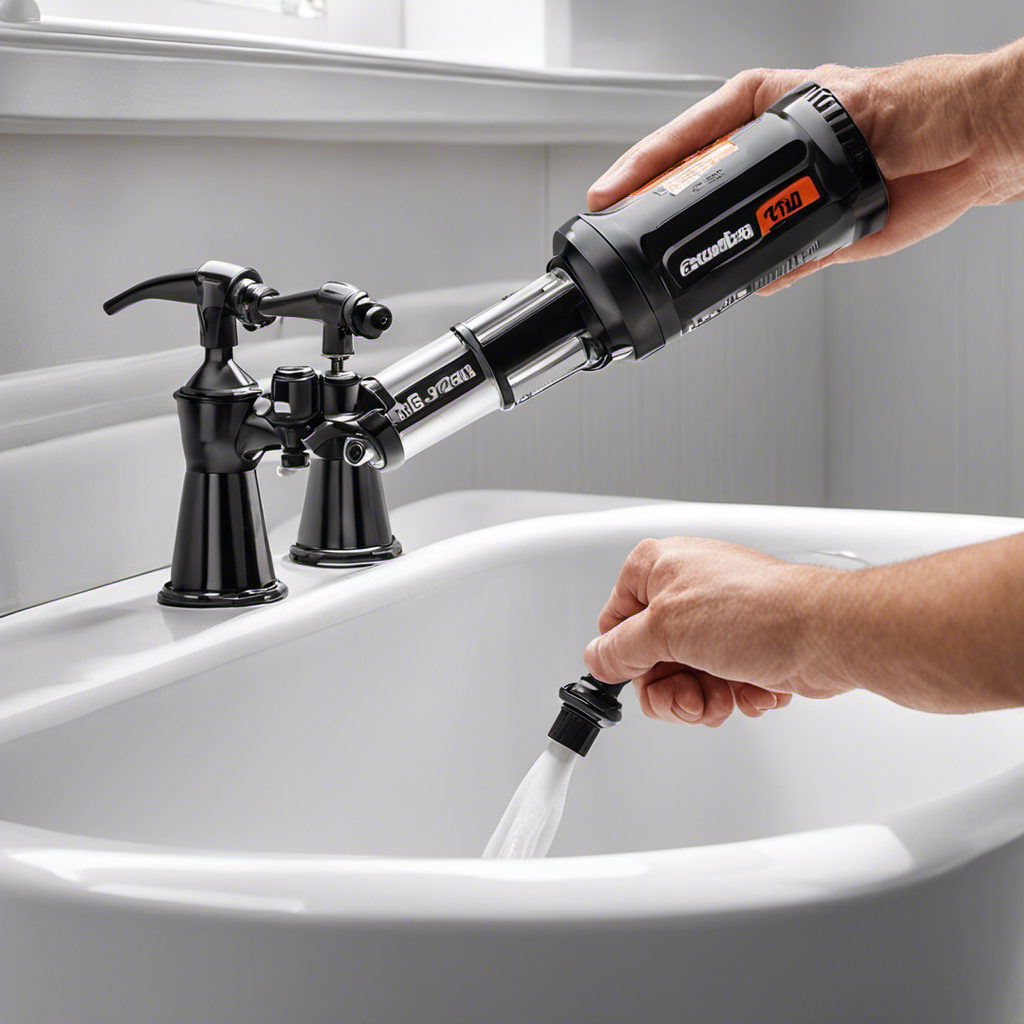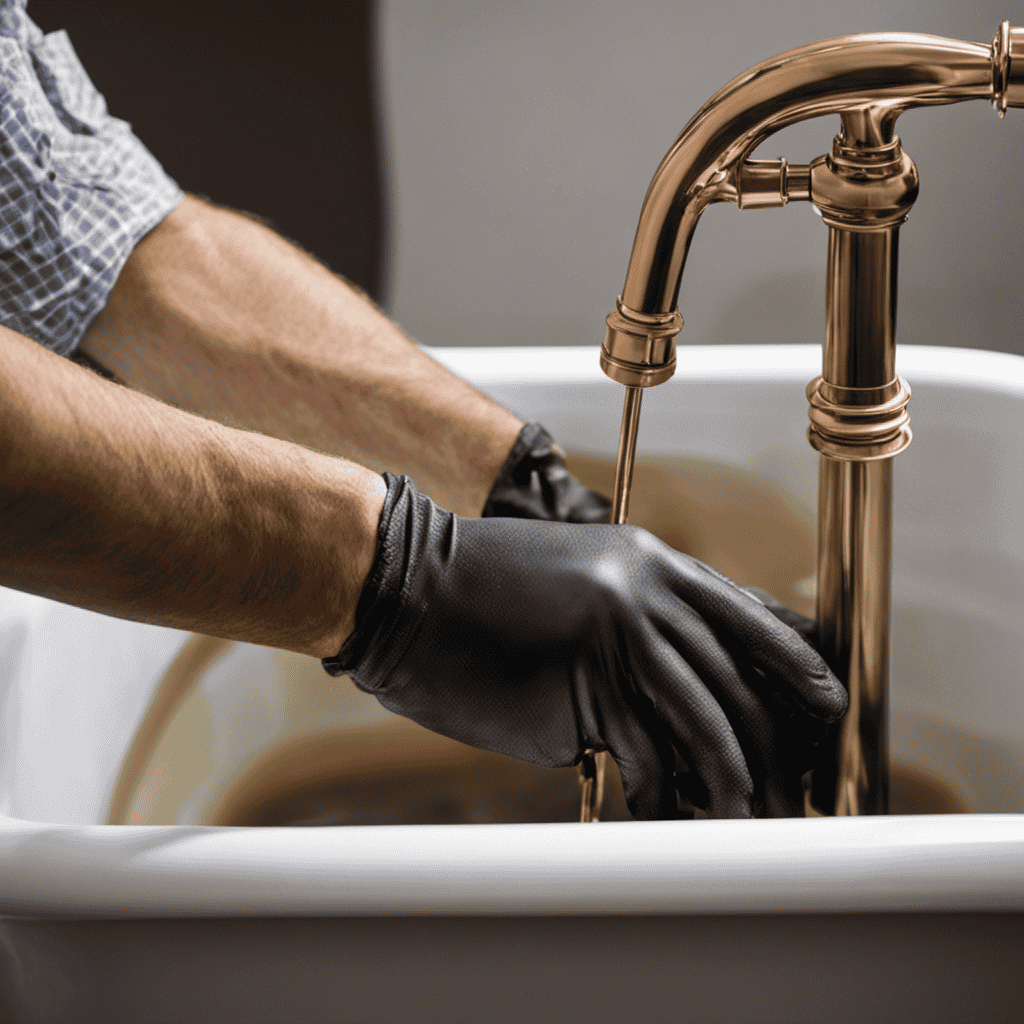Are you tired of dealing with that unsightly caulking in your bathtub? Say goodbye to the frustration and hello to a beautiful, caulk-free tub!
In this article, we will guide you through the step-by-step process of removing caulking from your bathtub. With just a few simple tools and a little bit of patience, you’ll have a clean and fresh-looking bathtub in no time.
So, let’s dive in and get started on your journey to a caulking-free oasis!
Key Takeaways
- Use the right tools and materials for caulk removal, such as a caulk removal tool or utility knife, scraper or putty knife, heat gun or hairdryer, rubbing alcohol, and a clean cloth.
- Prepare the bathtub by cleaning it with mild detergent and warm water, drying it completely, inspecting for mold or mildew, ensuring proper ventilation, and removing any loose or damaged caulk.
- Follow a step-by-step guide for removing caulk from the bathtub, including thorough cleaning and drying, avoiding sharp objects for scraping, considering alternative methods like caulk softener or a caulk removal tool, and following safety precautions.
- Use tips and tricks for easy caulk removal, such as applying caulk softener, using a caulk removal tool, heating the caulk before scraping, using a razor blade scraper for smooth surfaces, and preventing caulk stains with thorough cleaning and painter’s tape.
Tools Needed for Caulking Removal
Before starting the process, make sure you have all the necessary tools for removing the caulking.
There are a few essential tools you’ll need to effectively remove the old caulk from your bathtub. First, you’ll need a caulk removal tool or a utility knife with a sharp blade. These tools will help you cut through the caulk and remove it from the joint.
Additionally, you’ll need a scraper or a putty knife to help pry off any stubborn caulk remnants. A heat gun or a hairdryer can also be helpful in softening the caulk, making it easier to remove.
Lastly, have some rubbing alcohol and a clean cloth handy to wipe down the area after the caulk has been removed.
Following these best practices for caulk removal will ensure a smooth and successful process.
Preparing the Bathtub for Caulk Removal
To properly prepare the bathtub for caulk removal, it’s important to ensure the surface is clean and dry. Here are some steps to follow:
-
Start by thoroughly cleaning the bathtub with a mild detergent and warm water. This will remove any dirt, grime, or soap scum that may be on the surface.
-
Once the bathtub is clean, dry it completely using a clean towel or cloth. Any moisture left on the surface can affect the adhesion of the new caulk.
-
Next, inspect the caulked areas for any signs of mold or mildew. If you notice any, it’s important to take precautions, such as wearing gloves and a mask, to protect yourself from exposure.
-
Open windows or use fans to ensure proper ventilation during the caulk removal process. This will help to reduce the fumes and odors associated with caulk removal products.
-
Lastly, remove any loose or damaged caulk using a caulk removal tool or a utility knife. Be careful not to damage the bathtub surface while doing so.
Step-By-Step Guide to Removing Caulking From a Bathtub
After thoroughly cleaning and drying the bathtub, inspect the caulked areas for any signs of mold or mildew. It is important to address these issues before proceeding with the removal process.
Now, let’s talk about some common mistakes to avoid when removing bathtub caulking. One mistake people often make is using a sharp object, such as a knife or razor blade, to scrape off the caulk. This can cause damage to the bathtub surface and may even result in injuries.
Instead, consider using alternative methods for removing caulking from a bathtub. One effective method is using a caulk removal tool or a caulk softener, which helps to loosen the caulk so it can be easily removed. Another alternative is using a heat gun or a hairdryer to soften the caulk before scraping it off.
Remember to always work carefully and follow safety precautions to achieve the best results.
Tips and Tricks for Easy Caulk Removal
One way to make caulk removal easier is by applying a caulk softener to loosen it before scraping. This can save you time and effort in removing stubborn caulk from your bathtub.
Here are some tips and tricks for easy caulk removal:
-
Use a caulk softening product: Apply the softener to the caulk and let it sit for the recommended amount of time. This will make the caulk easier to scrape off.
-
Use a caulk removal tool: A caulk removal tool has a sharp edge that can easily cut through the caulk, making it easier to remove.
-
Heat the caulk: Use a heat gun or hairdryer to soften the caulk before scraping. This will make it more pliable and easier to remove.
-
Use a razor blade scraper: A razor blade scraper is perfect for removing caulk from smooth surfaces. Make sure to angle the blade to avoid scratching the bathtub.
-
Prevent caulk stains: Before applying new caulk, clean the area thoroughly and use painter’s tape to protect the surrounding surfaces from caulk stains.
Aftercare and Maintenance for a Caulk-Free Bathtub
Maintaining a caulk-free bathtub is simple. Just remember to regularly clean and inspect the edges for any signs of wear or damage.
To keep your bathtub clean and prevent the growth of mold, it is important to establish a regular cleaning routine. Start by wiping down the bathtub after each use to remove any soap scum or residue. Use a mild cleaner specifically designed for bathtubs to prevent damage to the surface.
Scrub the bathtub with a soft brush or sponge, paying special attention to the edges where caulk is usually applied. Rinse thoroughly to ensure all cleaning products are removed.
Additionally, it is important to keep the bathroom well-ventilated to prevent excess moisture, which can contribute to mold growth.
Frequently Asked Questions
How Long Does It Take for Caulk to Fully Cure?
To properly clean and prepare the surface before applying caulk, start by removing any old caulk using a caulk remover tool. After applying new caulk, it takes about 24-48 hours for it to fully cure. Yes, caulk can be painted over after it has cured.
Can I Use a Hairdryer to Speed up the Drying Process of Caulk?
Using a hairdryer on caulk to speed up drying can be effective, but proceed with caution. Excessive heat can damage the caulk or surrounding surfaces. Ensure proper ventilation and use low heat settings for optimal results.
What Is the Best Type of Caulk for a Bathtub?
The best type of caulk for a bathtub depends on your preferences and needs. There are various color options available, each with their own pros and cons. It’s important to choose a caulk that is waterproof and mold-resistant.
Can I Use a Knife or a Razor Blade to Remove Caulk From a Bathtub?
Using a knife or razor blade to remove caulk from a bathtub can be effective, but it comes with pros and cons. While it may be quicker, there is a risk of damaging the surface.
How Often Should I Recaulk My Bathtub?
To properly maintain your bathtub, it’s important to know how frequently you should reapply caulk and what signs indicate it’s time to recaulk. Let’s explore these topics in detail.
Conclusion
In conclusion, removing caulking from a bathtub is a straightforward process that can be easily accomplished with the right tools and techniques.
By following the step-by-step guide outlined in this article, you can successfully remove old caulk and achieve a clean, caulk-free bathtub.
While some may worry about the time and effort required, imagine the satisfaction of stepping into a pristine, freshly caulked bathtub, free from any unsightly residue.
With proper aftercare and maintenance, you can enjoy a beautiful, caulk-free bathtub for years to come.










